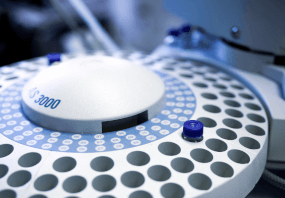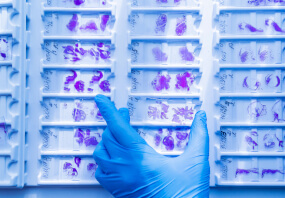β-NADH, a pyridine nucleotide and biologically active form of nicotinic acid, is a coenzyme necessary for the catalytic reaction of certain enzymes. β-NAD+ is a carrier for hydride ion, forming β-NADH. The hydride ion is enzymatically removed from a substrate molecule by the action of dehydrogenases such as, malic dehydrogenase and lactic dehydrogenase. These enzymes catalyze the reversible transfer of a hydride ion from malate or lactate to β-NAD+, forming the reduced product, β-NADH. Unlike β-NAD+, which has no absorbance at 340 nm, β-NADH absorbs at 340 nm. The increase in absorbance (with the formation of β-NADH) or the decrease in absorbance (with the formation β-NAD+) is the basis for measurement of activity of many enzymes at 340 nm. β-Nicotinamide adenine dinucleotide (NAD+) and β-Nicotinamide adenine dinucleotide, reduced (NADH) comprise a coenzyme redox pair (NAD+:NADH) involved in a wide range of enzyme catalyzed oxidation reduction reactions. In addition to its redox function, NAD+/NADH is a donor of ADP-ribose units in ADP-ribosylaton (ADP-ribosyltransferases; poly(ADP-ribose) polymerases ) reactions and a precursor of cyclic ADP-ribose (ADP-ribosyl cyclases). Many metabolites and enzymes of biological interest are present in tissues at low concentrations. With the use of β-NADH as a cofactor and several enzymes in a multistep system, known as enzyme cycling, much greater sensitivity for detection of these components is achieved. β-NADH is fluorescent; whereas, β-NAD+ is not. This difference in fluorescence provides a sensitive fluorescent measurement of the oxidized or reduced pyridine nucleotides at concentrations down to 10−7 M. Discussion of optimizing the fluorescence intensity and identification of interfering substances has been reported. NADH is a coenzyme that functions as a regenerating electron donor in catabolic processes including glycolysis, beta-oxidation and the citric acid cycle (Krebs cycle, TCA cycle). It participates in cell signaling events as well, for example as a substrate for the poly (ADP-ribose) polymerases (PARPs) during the DNA damage response. The NAD+/NADH dependent sirtuins play key roles in stress responses during events involving energy metabolism, with implications in cancer biology, diabetes and neurodegenerative disease. As a reagent, NADH can be used in enzyme cycling assays to amplify detection of activity of biologically relevant enzymes or metabolites present in low concentrations.
Shipping Information:
Dry Ice Surcharge & Ice Pack Shipments: $40
More Information: https://cenmed.com/shipping-returns
- UPC:
- 41106301
- Condition:
- New
- Availability:
- 3 Days
- Weight:
- 1.00 Ounces
- HazmatClass:
- No
- WeightUOM:
- LB
- MPN:
- 02101168.1
- Model Number:
- C830W15
- Temperature Control Device:
- Yes












